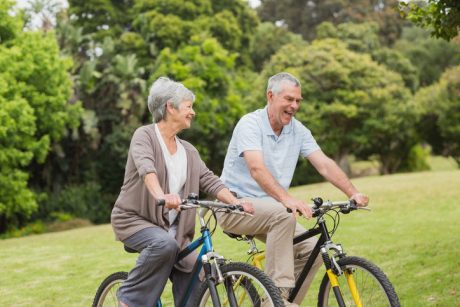Cycling’s Benefits For Parkinson’s Disease Patients
Posted April 17, 2018 at 5:48 am by Tim Dustrude
The following is a guest article written by Rebecca Evans, a Registered Nurse and Health Writer…
While there is still a great deal more not known about Parkinson’s than is known, one of the areas of research in which much progress is being made is that of exercise’s effects on Parkinson’s. While this was once merely anecdotal evidence, several studies have begun to put forth good data for the idea that exercise can help stall Parkinson’s advances.
In fact, neurologists’ number one treatment recommendation for Parkinson’s patients? Exercise.
While walking is one of the top recommendations, as are gentle exercise classes such as pool aerobics, cycling—and recumbent exercise bike cycling that can be fixed at certain speeds in particular—also have a great deal to justify their inclusion in a regular Parkinson’s exercise routine.
Parkinson’s and exercise
Exercise makes more sense for Parkinson’s patients as an important part of treatment when you think about Parkinson’s as a movement disorder. Given how dopamine disruption leads to slowness and difficulty in physical activity, it makes sense that putting concentrated effort into physical activity can help slow the progression and rate at which movement is decreased or hampered.
For instance, consider how we have seen Muhammad Ali and Michael J. Fox and their respective fights with Parkinson’s. By the end of Ali’s life, his movement was drastically inhibited. While Fox continues to fight onward—and the Michael J Fox Foundation is one of the leading Parkinson’s research foundations—he, too, has shown progressively more signs of his disease.
For many patients, Parkinson’s progress can eventually lead to difficulty with any form of movement, including speaking, talking, and breathing. Regular exercise, however, can help slow that progression.
What exercise is best?
While more research is yet needed, research currently available suggests that cycling may be one of the best therapeutic exercises available to Parkinson’s patients. For instance, Dr Jay Alberts of the Cleveland Clinic published research that showed riding one hour three times each week on a tandem bike could account for a 35% improvement in symptoms—an improvement that went away as soon as the exercise routine was stopped.
Why the tandem bike? Because it allows a second rider to help the Parkinson’s patient do more. If the non-Parkinson’s rider rides in the front, they are able to force a higher speed than if the Parkinson’s patients were riding on their own, thus helping the Parkinson’s rider move their legs more quickly than they otherwise would be able to.
As a result, it appears important that the ability to get the pedaling up to 80-90 RPMs is important—something that many Parkinson’s patients may not be able to do on their own. If, however, they are on an exercise bike that can be manually set, this problem is eliminated. (Note, however, it is important that the Parkinson’s patient is still working to move the pedals; if the pedals are rotating entirely on their own power, while some benefit will still be added from the forced movement, it will not be as great a benefit.)
And when it comes to recumbent or upright bicycles, both are good, but it appears recumbent bicycles may be better for Parkinson’s patients, as they provide greater support and engage more core muscles. Additionally, it is far more difficult to fall off a recumbent bicycle than an upright bike.
But what if I don’t have a recumbent bicycle?
Let’s be real: Any low-impact exercise is better than no exercise. While a recumbent bicycle on which you can maintain 80-90 RPMs is best, walking, water aerobics, yoga, and swimming are all also great options—and are all especially great options on the San Juan Islands!
Talk to your treatment team, too, and see what suggestions they have; they may well have other great tips, or even more research findings.
For more information, see this infographic.
You can support the San Juan Update by doing business with our loyal advertisers, and by making a one-time contribution or a recurring donation.
Categories: Education, Health & Wellness











No comments yet. Be the first!
By submitting a comment you grant the San Juan Update a perpetual license to reproduce your words and name/web site in attribution. Inappropriate, irrelevant and contentious comments may not be published at an admin's discretion. Your email is used for verification purposes only, it will never be shared.